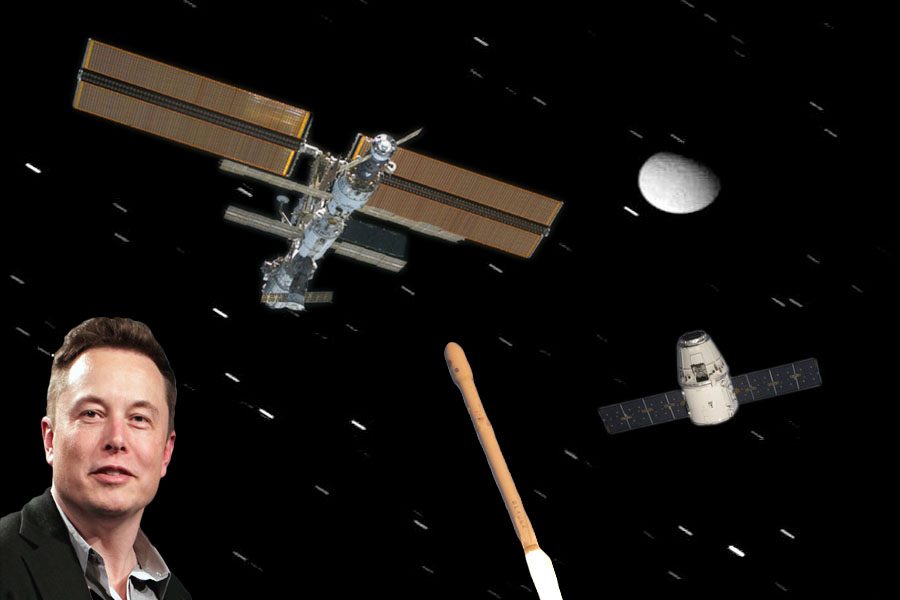SpaceX: From Grasshoppers to Falcons
April 20, 2017
In recent years, SpaceX, officially known as Space Exploration Technologies Corporation, has risen to fame after landing a booster stage on a barge last April. Since then, SpaceX has launched nine rockets and successfully landed seven of them (one booster did not even attempt to land). However, none of the recovered boosters had been returned to service- until Thursday, March 30th.
SpaceX was founded back in the summer of 2002 by a disgruntled Elon Musk, after failing to forge a deal with wealthy Russian businessmen for two refurbished Soviet intercontinental ballistic missiles (ICBMs) he had hoped to use to bring rats or plants to Mars. After his counterparts convinced him that the $30 million dollar budget to send a tiny ecosystem to Mars would barely purchase the rocket, Musk delved into books on the science of rocketry. After completing them, he ran the numbers, and believed he could start his own company and ultimately save massive amounts of money compared to what other rocket manufacturers were offering. Musk wanted to do things differently with his new startup. In order to cut costs and ensure parts were high quality, SpaceX resolved to do as much as possible without purchasing parts from other companies, a policy they still hold today.
In March 2006, SpaceX launched its first mission-rated rocket, the Falcon 1 in the Kwajalein Atoll. The maiden launch of the Falcon 1 was to be a simple flight, but a fire broke out a few seconds in, sending the rocket into a spin it would not recover from. Musk remained optimistic, and assigned a new team to develop a different, nine-engined rocket to be called the Falcon 9. In September 2008, SpaceX was preparing for the fourth launch of a Falcon 1, and rented a military cargo plane to fly the rocket out to hurry up the transport time. Because of the rapid pressure changes, the rocket nearly crumpled, delaying the launch by a few weeks. Later, the rocket would launch and successfully orbit, carrying a dummy payload.
Only two years after that, eight years after its founding, SpaceX’s next rocket, the Falcon 9, was ready for its first test launch. Over the next five years, five more Falcon 9 version 1.0s would launch, but none of them returned safely. The first two suffered a critical parachute failure, and the other three did not attempt to land. Then, in September 2013, the Falcon 9 version 1.1 was ready for its first commercial launch. The new version was heavier, longer, and more powerful than its predecessor. The most significant change of all, however, was the inclusion of four radially-mounted landing legs so the main booster stage could be returned and reused. The Falcon 9 v. 1.1 would be used from 2013 to 2016, launching fifteen different missions, with fourteen successful flights.
The Falcon 9 v. 1.1 would be phased out in 2016 by the Falcon 9 v. 1.2, better known as the Falcon 9 FT (full throttle). The new iteration of the widely successful Falcon 9 was also heavier, longer, and more powerful than its predecessor. The Falcon 9 FT also featured an upgraded version of the grid fins used for landings. Since its first commercial launch in December 2015, the Falcon 9 FT has launched thirteen missions and successfully brought the payload to its destination twelve times (the FT had a perfect record until the explosion of the Amos-6 mission on the launch pad), and landed back on the launch pad or on a barge nine times. Each of the thirteen missions used a brand-new first stage, instead of using one of the recovered boosters.
Until March 30th, that is.
It was a bright, partly cloudy afternoon in Cape Canaveral. Hundreds watched on the shores of Cape Canaveral as the 230-foot, 600 ton giant sat motionless on pad 39A- the very same launch pad that every Apollo mission launched from. This was no ordinary rocket. The first stage, B1021 (the serial number of the booster), would be the first booster stage to be reused, building on the chief principles of SpaceX, re-usability and cost-effectiveness. This was also the first booster to be successfully returned to the drone ship, “Of Course I Still Love You”.
The payload, SES-10, is a communications satellite run by SES S.A. and will be placed in geostationary orbit. Essentially, objects in geostationary orbits have the same rotational period (or how many times the object makes a full rotation in one Earth day) as Earth, so they seem motionless in the sky to people on the ground. According to SES S.A., “SES-10 will replace AMC-3 and AMC-4 to provide enhanced coverage and significant capacity expansion over Latin America. The satellite will provide coverage over Mexico, serve the Spanish speaking South America in one single beam, and cover Brazil with the ability to support off-shore oil and gas exploration,”
At 6:27 p.m. EDT, the SES-10 mission went underway. The Falcon 9 FT fired off over the North Atlantic, bringing the payload into space. About a minute and a half into the flight, the Falcon 9 FT reached what is called Max-Q, or the point at which mechanical stress is at its peak on the rocket. A minute or so later, the booster stage, B1021, separated from the rest of the rocket and began falling back to Earth. For about three minutes, or six minutes after launch, the first stage fell back to Earth as the second stage powered through the upper atmosphere. At six minutes and nineteen seconds into the flight, B1021 began to slow itself down and guided itself towards the landing barge, “Of Course I Still Love You”, and finished its burn two minutes and thirteen seconds after that, when it landed successfully.
As the SpaceX headquarters in Hawthorne, California exploded with cheers and celebration, the second stage continued towards its goal for another twenty-four minutes. The mission was a resounding success.
Later this month, on April 30th, SpaceX will launch a classified payload into low Earth orbit (LEO) for the National Reconnaissance Office, which will be its first mission for the NRO. Between now and August 1st, SpaceX has scheduled nine Falcon 9 launches. Sometime in the third quarter of 2017, SpaceX’s new rocket, the Falcon Heavy, is expected to make its first demo flight, carrying a dummy payload. A more complete launch schedule for this year can be found here, courtesy of SpaceFlightNow.
Since the Falcon 9 entered service, it has been very popular among observers and companies alike. The Falcon 9 has a near-perfect record, rivaled only by the United Launch Alliance’s Delta IV and Delta IV Heavy. The Falcon Heavy, SpaceX’s newest rocket, aims to expand SpaceX’s lifting capabilities to LEO and beyond, possibly even Mars. The Falcon Heavy features three booster stages very similar to the Falcon 9’s, with a total of twenty seven Merlin D engines. The booster stages of the Falcon Heavy are also tasked with returning to a landing site to be reused- just like B1021 was in March.
“I think that SpaceX is doing good work, creating a commercial market (or at least paving the way for one) for space. SpaceX is also doing things even government space programs haven’t done, such as their famous landing boosters on barges. They are doing a good job of moving the responsibility of space travel from a government agency like NASA or ESA and creating competition with other companies such as Blue Origin, so that there’s even more motivation to advance rockets and space travel,” said sophomore Koen Arnell.
The Falcon Heavy and further modifications of the Falcon 9 will propel SpaceX farther into space- and farther ahead in its competition with ULA and Blue Origin. More info on the increasingly privatized space industry can be found here.


